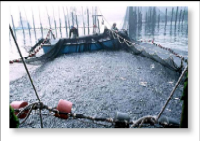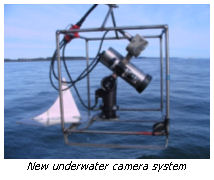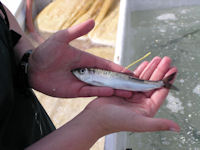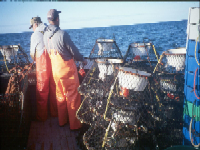Managed Fisheries Research
Science advice produced by SABS guides management of groundfish and herring on Georges Bank, the Scotian Shelf and the Bay of Fundy; bluefin tuna and swordfish in the Canadian Atlantic Zone; and herring, lobster, crab and sea urchin in the Bay of Fundy. All are active and valuable fisheries. Our researchers provide and analyse scientific data used in the management of these resources, resulting in peer-reviewed documents.
Groundfish
Georges Bank, southwest Scotian Shelf and Bay of Fundy groundfish are economically important for the region. Cod, haddock and yellowtail flounder on Georges Bank are considered transboundary resources and are subject to directed fisheries in both Canadian and United States waters. Staff participate in the Transboundary Resource Assessment Committee (TRAC) and the Transboundary Management Guidance Committee (TMGC) where these Georges Bank stocks are assessed and managed cooperatively. The Scotian Shelf and Bay of Fundy groundfish stocks, including cod and pollock, are assessed in the DFO Maritimes Regional Advisory Process (RAP), where our staff play an important leadership role.
Herring
 The herring fishery is a vital industry for the southwest Nova Scotia, Bay of Fundy and coastal areas from Cape Breton to Grand Manan. Our researchers provide scientific advice on herring stock status and biology through the DFO Maritimes Regional Advisory Process (RAP), to assist management and increase knowledge of the various herring fisheries. Decisions regarding the appropriate distribution and rates of fishing during the season are based on the latest available information including Hydroacoustic Surveys and biological sampling so as to allocate fishing effort appropriately.
The herring fishery is a vital industry for the southwest Nova Scotia, Bay of Fundy and coastal areas from Cape Breton to Grand Manan. Our researchers provide scientific advice on herring stock status and biology through the DFO Maritimes Regional Advisory Process (RAP), to assist management and increase knowledge of the various herring fisheries. Decisions regarding the appropriate distribution and rates of fishing during the season are based on the latest available information including Hydroacoustic Surveys and biological sampling so as to allocate fishing effort appropriately.
Scientists from Fisheries and Oceans Canada (DFO) and the Herring Science Council are working together to learn more about herring abundance and behaviour. The council brings together processing and harvesting industries to coordinate their contribution to DFO’s scientific data collection and assessment process.
 Dr. Gary Melvin, of DFO’s St. Andrews Biological Station (SABS) in New Brunswick (N.B.), is the lead scientist for the studies. According to Melvin, “This new technology and continued collaboration with the Council will allow us to better understand and estimate the herring populations in these areas. This will be invaluable in providing improved advice for herring stock assessment and its subsequent management.”
Dr. Gary Melvin, of DFO’s St. Andrews Biological Station (SABS) in New Brunswick (N.B.), is the lead scientist for the studies. According to Melvin, “This new technology and continued collaboration with the Council will allow us to better understand and estimate the herring populations in these areas. This will be invaluable in providing improved advice for herring stock assessment and its subsequent management.”
These projects are building on a long cooperative history. Since 1998, with a hydroacoustic system developed by SABS staff, herring vessel captains have recorded the depth, density and location of herring with the simple push of a button. This information provides an assessment of herring distribution and abundance during the spawning and fishing seasons. However, this equipment does have a limited Target Strength (TS) (the acoustic signal returned from each individual fish), which is a key component in obtaining accurate abundance estimates.
The new portable equipment (i.e. eco-sounders and underwater cameras), employed since 2008, uses multi-frequency, split-beam echo sounder technology and provides better TS estimates. With this equipment, the team is investigating “acoustic blind zones” (areas close to the ocean bottom and in the water above the fishing boat hull) where traditional downward looking hydroacoustic technology can miss fish. Scientists are now questioning abundance estimates as herring have shown recent changes in behaviour. For example, herring are staying deeper and near the bottom instead of moving to the surface after dark. Underwater video cameras and the portable echo sounder are being deployed from fishing boats on the German Bank (off southwest N.S.) spawning ground to observe the fish. This information will allow for better understanding of fish behaviour and estimates of fish near the bottom.
 Additionally, in the fall of 2009, the team embarked on a three-year tagging program to investigate turnover rates (movement to other areas) of individual fish on German Bank spawning grounds. In the past, during assessments and surveys, it was assumed that there was a complete turnover of spawning fish after 10 – 14 days. However, more recent tagging studies indicate that some fish remain on the spawning ground for up to five weeks, while others leave in seven days or less. This large variability could lead to estimation errors in the spawning stock abundance. With this program, fish are being tagged and returned to the water during normal fishing operations. When tagged fish are recaptured, processors are asked to return tags to the SABS along with information such as fish length, weight and catch location. Those who return tags are eligible for a $1000 draw with funding provided by the Herring Science Council.
Additionally, in the fall of 2009, the team embarked on a three-year tagging program to investigate turnover rates (movement to other areas) of individual fish on German Bank spawning grounds. In the past, during assessments and surveys, it was assumed that there was a complete turnover of spawning fish after 10 – 14 days. However, more recent tagging studies indicate that some fish remain on the spawning ground for up to five weeks, while others leave in seven days or less. This large variability could lead to estimation errors in the spawning stock abundance. With this program, fish are being tagged and returned to the water during normal fishing operations. When tagged fish are recaptured, processors are asked to return tags to the SABS along with information such as fish length, weight and catch location. Those who return tags are eligible for a $1000 draw with funding provided by the Herring Science Council.
The team is optimistic that this collaboration and use of new equipment will lead to an increased understanding of herring population estimates and behaviour, which is valuable information for effective management of the species.
Large Pelagics
Since tunas and swordfish are highly migratory fish that range over the entire Atlantic Ocean, they are managed internationally by the International Commission for the Conservation of Atlantic Tunas (ICCAT). Canada is one of more than 40 Contracting Parties of ICCAT. Although Canada’s catches are relatively low in the Atlantic-wide scheme of things, DFO plays a key role in the scientific and management committees, consistent with Canada’s strategy to strengthen International Fisheries Governance.
Invertebrate Fishery
 Invertebrate species are of great economic importance in the Bay of Fundy. Lobster, Jonah crab, rock crab and sea urchin fisheries are monitored and studied by our staff. Lobster research includes studies on the early life cycle, habitat and migration patterns. Jonah crab, rock crab and sea urchin are newer fisheries to the region and Section staff monitor their populations with the help of the commercial fishing industry.
Invertebrate species are of great economic importance in the Bay of Fundy. Lobster, Jonah crab, rock crab and sea urchin fisheries are monitored and studied by our staff. Lobster research includes studies on the early life cycle, habitat and migration patterns. Jonah crab, rock crab and sea urchin are newer fisheries to the region and Section staff monitor their populations with the help of the commercial fishing industry.